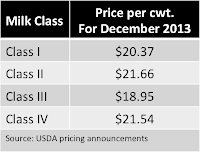INVENTORIES
Beginning with the largest and most important product, cheese, the two charts below show the current level of natural and American cheese stocks. Cheese prices are the primary element in the Class III milk pricing formula. High inventories can result in reduced prices, which were a concern in early 2013. By November, the inventories have fallen to reasonable levels, just above the levels for 2011/12 for this time of the year. The November NASS price for wholesale cheese was $1.88/lb. This was not even near to the price level spikes of 2004, 2008, and 2011, so the price does not indicate any type of disruptive bubble.
The other two items important to Federal Order Pricing are dry whey and nonfat dry milk. Dry whey pricing is used to calculate the price of "Other Solids" and nonfat dry milk is used to calculate the Class IV milk price.
As mentioned above, nonfat dry milk pricing is the basis for the Class IV milk price. The Class IV milk price has been extremely good as was reviewed in the prior post to this blog. The majority of nonfat dry milk is exported so pricing is dependent on international prices.
EXPORTS
Exports through November remain excellent. Cheese exports reached an all time high in November. Domestic consumption makes up 94% of cheese disappearance and export volume is only 6. This presents an opportunity for growth through increased exports.
Surprisingly, butter exports fell. Butter production was lower which helped keep the inventories low. Even though the exports fell, they still represent a record high for the month of November.
EXCHANGE RATES
Exchange rates remain positive for U.S. exports. The two charts below show the USD exchange rates against the two other major dairy export currencies, the Euro and the New Zealand Dollar. The USD/Euro chart shows that the USD has weakened in 2013 making U.S. dairy products less expensive in the global markets.
The New Zealand Dollar is currently near the average exchange rate for 2013. And compared to four years ago, the USD is significantly weaker.
















